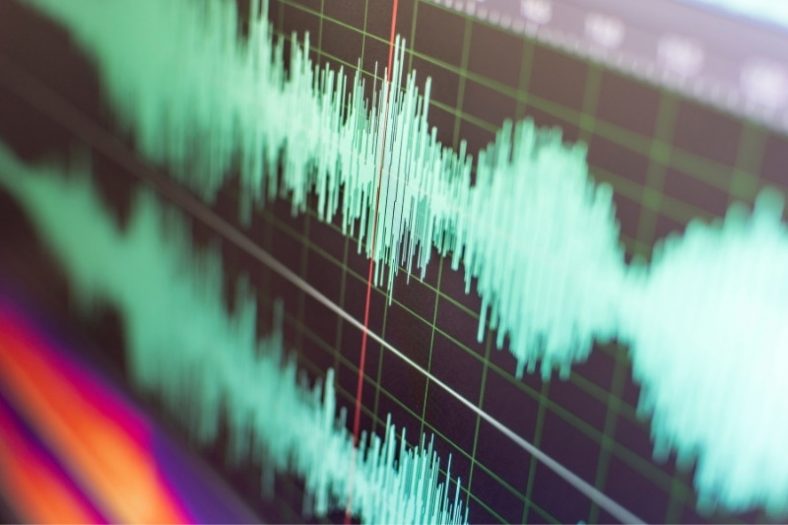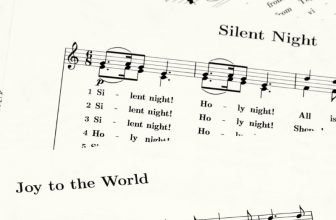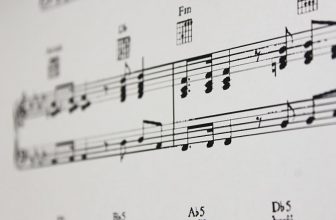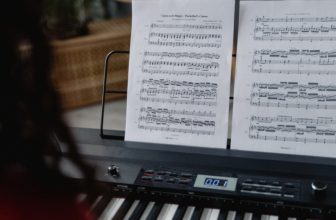What are Overtones in Music?

An overtone is a sound that has a higher frequency than fundamental frequency of a certain sound. For example, when you pluck a guitar string, the lowest pitched sound generated from the vibration of the strings is the fundamental frequency, all sounds pitched above that are overtones.
An overtone is essentially the character of a particular sound you would hear. To put it simply, an overtone helps identify the timbre – the color or quality of the tone or how it is perceived.
If you need a crash course on soundwaves and how we perceive sound, check out our short article on “What Determines The Pitch Of A Sound?”.
The fundamental frequency, known as the first harmonic, doubles as a result of the pitch vibrating in half. The first overtone or second harmonic is one octave above the fundamental. When the pitch vibrates in thirds, it generates a sound that is three times the fundamental frequency. One octave and five whole tones higher than the fundamental is the second overtone, sometimes known as the third harmonic.
The pitch vibrates at even higher frequencies, but the overtone grows weaker with each higher frequency.
Contents
The Overtone Series
An overtone series is not only a group of overtones because there is a hierarchical order in this group. Each overtone takes its place on the row depending on its frequency level. Also between the overtones, there are those with higher frequencies and those with lower frequencies.
Frequencies vibrate after the connection between two items. These items’ shapes also have a huge effect on what kind of standing wave you’ll have. Besides, calculating the values of overtone frequencies may be more or less complicated due to the items’ shapes.
Sound is complicated. Every time the human voice sings or talks, it produces a stack of related tones that follow a regular succession. For example, if I play a C2 on the piano, it is the fundamental note. The overtones would be as follows:
C2 – C3 – G3 – C4 – E4 – G4 – Bb4 – C5 – D5 – E5 – F#5 – G5 – A5 – Bb5 – B5 – C6
Bb4, F#5, A5, and Bb5 aren’t in tune, but they’re close to the correct pitch. In other words, approximate pitch.
This is why chords need to be tuned in a very specific way; they need to be in line with or in tune with this overtone series. That is why, for example, the fifth (G) of a chord (C Major) must be tuned somewhat higher than a piano. In contrast, the seventh or dominant seventh (Bb) must be tuned lower than a piano.
What Exactly Are Harmonics?
The integer multiples of the fundamental frequency or lowest vibration frequency make up harmonic frequencies. If you take a look at a string that is vibrating, you’ll see the vibration modes are all multiples of the fundamental. Both the string’s length and the speed of the wave influence them.
The frequencies which are integer multiples based on the fundamental tone’s frequency can be called harmonics. Imagine starting with a 100Hz fundamental frequency. If we multiply a frequency by any integer, the result is an integer. On the other hand, if the factor is substituted into an absolute value, it is integral.
How are overtones and harmonics different?
In general, overtones and harmonics are considered in connection to sound sources. For this reason, both of these concepts are usually mistaken and used interchangeably.
You may find that overtones and harmonics refer to the same set of frequencies in particular contexts. So harmonics can indeed be overtones, and overtones can be harmonics. Still, the opposite case is possible in the meantime. In other words, some harmonics are not overtones and some overtones are not harmonics.
Overtones are whole-number frequencies where resonance occurs above the fundamental frequency. Multiple frequencies come up due to resonance. In rare circumstances, resonance may occur only at harmonics or only at specified values or all values. This is referred to as a harmonic progression effect.
Resonance occurs just after systems are subjected to external vibrations that match their inherent frequency. No matter overtones or harmonics, they both are resonances in the end.
To clarify the difference, “overtones” refer to any standing wave at a higher frequency. And “harmonics” refer to circumstances in which the overtone frequencies arise.
Sound waves in an open pipe or a vibrating string are examples. They should be identical when it comes to harmony and overtones. It is only at odd harmonics that overtones develop in a closed pipe.
Drum heads and other rectangular or circular membranes, such as a guitar fretboard, are good examples of what you get. Knowing this, some of the sounds on a rectangular membrane also have harmonics, but not all of them do.
The wavelength, Frequency, and Wave Speed
Before going on to harmonics and overtones, it is vital to understand the principles of a wave. Waves are disturbances in a medium that propagate from one area to another through oscillating points inside the medium. Besides sound, there are waves on a string, even in the sea, as other examples to give.
The wavelength description is the distance between its highest and lowest points.
The frequency is how many times a wave repeats itself every second.
Finally, the wave speed is a calculation of the sum of wavelength and frequency.
These are the noises that you may find in nature. We are only strengthening them. The purpose of these studies is not to compete with the existing sounds. Instead, we want to improve them and let them ring out freely.
Frequencies and Resonance
A succession of frequencies accompanies a musical instrument’s fundamental pitch. Still, we hear only the fundamental tone because we perceive these frequencies combined in a single tone.
Imagine the producing process of a harmonic. In music, harmonics are multiples of the frequency of a particular pitch. Playing a harmonic is possible by producing one of these harmonics without resonating the fundamental.
However, you may still have the question of why or how in your mind. There are still things missing in these definitions. To understand better what a harmonic or an overtone is, we need to understand frequency.
When a spreading disturbance is restricted, it has the potential to reflect and cause interference with the actual source. This results in a continuous standing wave at certain frequencies. For example, these things happen when you play a string, blow into a pipe, or even drop a spanner on the ground. When the spanner hits the ground, it vibrates briefly, which makes it sound like it’s ringing.
The standing waves can develop with resonant frequencies. They are determined by the physical features of the material in which they are applied. To put it another way, the values of these frequencies might change depending on the medium. For example, string length, mass density, and pressure all affect the frequency at which a standing wave is generated in a string.
Soundwaves
A few sound basics are necessary at this point. The frequency controls the sound pitch. Oscillations in a waveform may occur at varying speeds or frequencies. As they travel faster, the frequency of their occurrences rises. If the frequency goes higher, the pitch does too.
Partial tones are a mixture of various frequencies that composes the sound. When your ears detect the lowest frequency, you sense the sound’s “pitch.” All the various partial tones that make up the sound also make up the sound’s timbre or tone color.
There is a multitude of partials linked with each waveform. By this means, many different sounds go into making a sound unique. The shape of a waveform also changes the sound because the partials themselves start to move around.
Different Waveforms
For synthesis and sound in general, waveforms are the fundamental building blocks of sound. Oscillators in synthesizers produce repeating waveform impulses. The waveform suffers an alteration in some way during synthesis.
But, waveforms occur in various shapes and sizes. This is a basic explanation. The reason is that each waveform has a unique set of characteristics. This means that each waveform makes a different sound. Producing and mixing different kinds of music requires a good understanding of waveforms.
Sine Waves, Saw Waves, and Square Waves
Sine Waves
A true sine wave does not have any overtones, it only contains the fundamental note. It’s uncommon to hear true sine waves in everyday life, though you can get close them by using synthesizers.
You may use a sine wave to generate a nice deep tone that doesn’t interfere with the bassline you’re creating. Also, by combining a succession of sine waves, you may produce any other waveform.
Another important feature is that they can be added together. In this way, they form a sum. In reality, one synthesis approach (Fourier synthesis) is concerned with sine waves. Timbres are controlled by varying the amplitude and phase of discrete sine waves. This is referred to as “additive synthesis.”
Saw Waves
A sawtooth wave is commonly known as a saw wave, which is more jagged. But, in terms of harmonics, it has the most to offer. And this feature makes it sound even buzzier than other waves do.
The sawtooth wave contains all the overtones and can filter undesired overtones. A low pass filter, for example, filters out the high partials while allowing the low partials to pass. “Subtractive synthesis” is a term used to describe this method.
A good example can be the waves created by a string and a bow. When you produce a violin’s typical buzzy sound, the ramp and flyback of a saw are used in conjunction with the interaction between the bow and the string.
Square Waves
Because it has extra odd harmonic content, the square wave is more complicated than the sine wave. You can think of a harmonic as a kind of partial tone. It has the same frequency as its source but is a whole multiple of it. The formation of the harmonics occurs in a square wave.
The form of a square wave is simply square. This wave has a square form due to the harmonics and the fundamental tone. The sound gives that edgy feeling.
When you look at a waveform graph, the frequency changes from its lowest value to its highest value right away. There is no gradual change like there is in the sine wave.
Additionally, triangle waves are similar to square waves. They have a foundational sound and odd harmonics like square waves do.
Each of their harmonics has less power compared to the square wave. It means that in a triangle wave, the strength of the harmonics falls two times faster than it does in a square wave.
Summary
An overtone is a frequency that is above the fundamental frequency of a sound. Harmonics are overtones with frequencies that are integer multiples of the fundamental. In other words, it’s when you take away or add numbers from one another to make a certain multiple.
The overtone frequencies arise from the production of harmonics. When a sound wave is produced, it causes disturbances in the medium that propagate from one point to another. These disturbances create waves, described by their wavelength, frequency, and wave speed.





